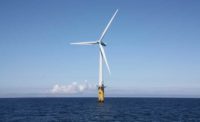The 130-turbine Cape Wind project off the coast of Massachusetts has spurred more support for offshore wind generation, including a $199-million terminal construction at the Port of Paulsboro, N.J., and a $35-million project on the waterfront in New Bedford, Mass.
That new port infrastructure as well as recently announced federal programs to support offshore wind infrastructure may finally help launch the U.S. offshore wind industry, which has lagged behind countries such as the United Kingdom and Denmark where the offshore supply chain was developed years ago.
New Bedford is Cape Wind’s designated hub for offshore wind staging and assembly. Kristin Decas, executive director of the New Bedford Harbor Development Commission, says the port was selected for its lack of obstructions and proximity to Cape Wind, which is sited in Horseshoe Shoal, Nantucket Sound, off the coast of Massachusetts.
In an unusual turn of events, dredging for an Environmental Protection Agency cleanup in its coastal waters helped streamline approval for construction of the terminal facility, Decas says. Decas expects EPA approval for construction by mid-April, with work beginning in June and ending in December. Apex Engineering, Tacoma, Wash., is engineer for the project.
Wind Farms and Supply Chains
Scott Lang, New Bedford’s mayor, says the town is working closely with Cape Wind and other companies to determine how to create a flexible port with heavy lifts and heavy manufacturing to service industries that support offshore wind. He says the historic whaling-era seaport is positioned to serve offshore wind manufacturers with a highly skilled workforce, a hurricane barrier and 500 commercial fishing vessels operating daily. “We could complement New Jersey, New York, Rhode Island and others up and down the coast,” he says.
In addition to the 28-acre terminal site, Lang says two nearby 20-acre parcels of deepwater property could provide space to support offshore wind energy and ocean-based alternative-energy infrastructure needs.
A joint venture of Mass Tank Sales Corp., Middleboro, Mass., and Germany’s Erndtebrucker Eisenwerk GmbH & Co. KG (EEW), Rostock, is fabricating the 130 monopiles and transition pieces for the wind turbines. The foundations will support 3.6-MW turbines powering the 468-MW project, which secured final approvals last month from the EPA and U.S. Army Corps of Engineers, reports the developer, Cape Wind Associates, Boston.
Ownership of the public facility is still under discussion, but Decas says she expects it will be owned and operated by a consortium of state and local interests with financing from state, local and federal sources.
New Jersey also plans to build a terminal to support offshore wind development and has received about $200 million from bonds and grants to pay for the project. Michele Siekerka, assistant commissioner for Economic Growth and Green Energy at the New Jersey Dept. of Environmental Protection, says the state has identified the Port of Paulsboro in Gloucester County as a redevelopment site for offshore wind energy. She predicts that the port will be ready for offshore wind manufacturing within a year.
Marlin Peterson, construction project manager at the Gloucester County Improvement Authority, which will oversee the port construction, says demolition of the existing infrastructure began in September and is substantially complete. The authority has received state environmental permits and the Corps of Engineers has awarded two significant contracts totaling $65 million—including $48 million for bulkhead dredging and subgrade and $16 million for access-road and bridge construction, he says.
Jay Jones, deputy executive director at the Port of Paulsboro, says the design of the public port-terminal facility will serve the import/export needs of the offshore wind industry and include manufacturing space. In addition to receiving offshore wind components, including 70-ft to 100-ft-long turbine blades and 125-ton monopole foundations, turbines will be assembled and moved onto jack-up barges for shipping to offshore installation sites, he says.
CH2MHill, Englewood, Colo., is engineer for the terminal infrastructure and building, and Weeks Marine, Cranford, N.J., is contractor for the bulkhead. Philadelphia-based Pennoni Associates is engineer for the access road and bridge, with AP Construction, Blackwood N.J., serving as contractor.
Once completed, the four-berth concrete wharf will measure about 3,000 linear ft. Construction of the first two berths is expected to begin in 2012. Peterson says with permitting and financing in place, the port is now in negotiations with potential users of the port facility.
More Incentives in the Air
New Jersey is offering many offshore-wind-energy incentives to attract wind developers and manufacturers “up and down the supply chain,” Siekerka said. For instance, companies can receive up to $100 million in tax credits for capital costs if they operate in a wind-energy zone such as Paulsboro Port.
In addition to individual state action to develop the offshore industry, the U.S. Dept. of the Interior and the U.S. Dept. of Energy recently recognized the infrastructure barriers to offshore development and released a strategic plan to overcome them. The two departments are spending $50 million on research projects to help reduce the timeline to develop the wind-energy supply chain, including port-side staging and fabrication facilities as well as specialized vessels for turbine installation.
“Through the Strategic Work Plan, the United States is synchronizing new research and development initiatives with more efficient, forward-thinking planning so that we can help quickly stand up an American offshore wind industry,” said Ken Salazar, secretary of the Dept. of Interior, in a statement.
The Dept. of Interior also announced it will fast-track permitting for offshore wind development off the coasts of Delaware, Maryland, New Jersey and Virginia. The Dept. of Energy’s goal is to develop 54 GW of offshore wind by 2030, at a cost of 7¢ per kWh. By contrast, Cape Wind is selling part of its power to international energy delivery company National Grid for almost 19¢ per kWh.
In related news, on Feb. 11, Maryland Gov. Martin O’Malley (D) introduced legislation that would direct the state’s largest utilities to purchase between 400 MW and 600 MW of offshore wind. Several developers have expressed interest in developing wind farms off Maryland’s coast.









